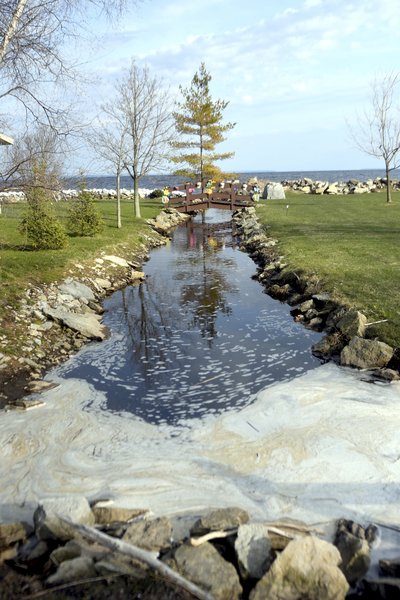Elusive question of PFAS foam
By John Liesveld | EagleHerald Publishing | April 23, 2020

Read the full article by John Liesveld (EagleHerald Publishing)
“MARINETTE — When Marinette residents Larry and Linda Phillips noticed the milky, off-white foam coalescing atop the water in the stream (aka Ditch C) running along their property, the sight unsettled several levels of concern over the persistent issue of PFAS (per- and poly-fluoroalkyl substances) contamination throughout the area.
At the emotional level, Larry imparted two words to describe his and his wife’s reaction on Sunday evening to the frothy amalgamation undulating near the culvert where Ditch C tunnels under West Bay Shore Street from the Marinette Nature Walk area just before it spills into Green Bay.
‘Scared and anxious,’ he said.
Ditch C represents one of several ditches in the Marinette area tainted by a large plume of PFAS-contaminated groundwater centered on the Fire Technology Center (FTC), which is owned by Tyco Fire Products LP, a subsidiary of Johnson Controls Inc. (JCI). In the areas of Marinette and the Town of Peshtigo, widespread groundwater and other environmental contamination occurred after decades of testing firefighting foams, which contain PFAS, at the FTC.
Sunday was not the first time the Phillips spotted such foam buildup near the mouth of the culvert; however, its accumulation exceeded the amount at any other time.
‘Last night was a bumper crop,’ Linda said. ‘We’ve had (foam) three different times but last night was just so gooey and full.’
Sunday’s sighting would not be last. While the foam dissipated overnight, vanishing completely by Monday morning, it reemerged Wednesday evening.
PFAS FOAM?
According to the Wisconsin Department of Natural Resources (DNR), PFAS compounds can accumulate in surface waters, resembling a sticky shaving cream-like substance. In addition, naturally occurring foam can form on surface water as a result of various compounds emitted by decaying plants. In November, DNR Environmental Division Administrator Darsi Foss pointed out that, based on testing and appearance, PFAS foams and naturally-occurring foams can be very similar in appearance, prompting DNR officials to warn people to avoid interaction with all surface water foams.
Samples of surface water at Ditch C and two other ditches (A and B) in the Marinette area have revealed varying levels of PFAS in the past. According to the latest results from samples taken in 2019 between March and April, those levels ranged from below 10 parts per trillion (ppt) to above 2,000 ppt, depending on which ditch and where along the ditch those sample collections occurred. The March 2019 sample collected from Ditch C, near the Phillips’s home, contained 4.2 ppt of PFOS and 12 ppt of PFOA.
PFOA and PFOS represent the two most widely used and researched PFAS compounds. Over 4,7000 different varieties of the manmade PFAS substances exist.
Currently, the State of Wisconsin has no legal standard regarding safe levels of PFAS in groundwater, surface water or drinking water. When it comes to ‘recommended’ safe levels of PFAS, Wisconsin follows guidelines issued by the U.S. Environmental Protection Agency (EPA) that established a health advisory limit (HAL) for safe drinking water at 70 ppt. HALs serve only as recommended margins of protection from toxic substances and are not enforceable standards.
According to Dave Neste, a hydrogeologist with the DNR, ever since Wisconsin Gov. Tony Evers issued his COVID-19 stay at home order, an increasing number of foam reports in the area have made their way to Neste. The sightings continue to give residents concern as many believe such foams might be PFAS-related. However, because of social distancing and safety concerns over the pandemic, the DNR is not currently sending officials to examine or test those foams.
‘I received about two reports per week,’ Neste said. ‘So (the DNR) has been logging them, and we will try to verify reports after the COVID-19 stay-at-home order lifts … but some of these foams dissipate quickly. So we are telling people to assume the foam is PFAS and inform them not to touch it.’
That warning is backed by samples taken in November of agglomerations of foam floating on the Peshtigo River. Analyses revealed extremely high PFAS concentrations in those samples of up to 17,000 parts per trillion (ppt).
PFAS FEARS AND HEALTH
The Phillipses moved into their home next to Ditch C about 17 years ago; for about the first eight years a private well on the property siphoned water through their faucets. That well water boiled their food, cleaned their dishes and their hands and provided for numerous other household activities and tasks…”
This content provided by the PFAS Project.
Location:
Topics: